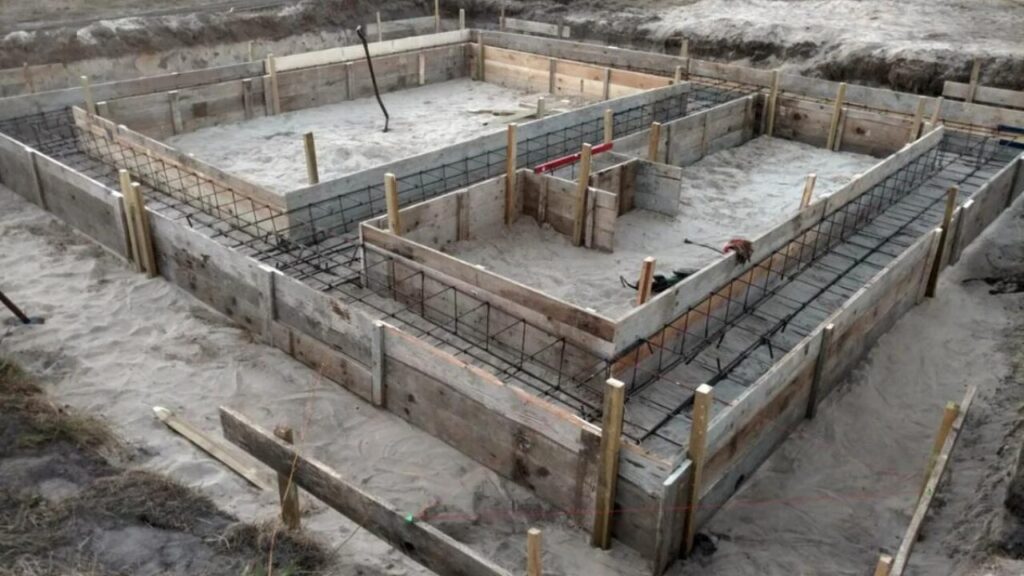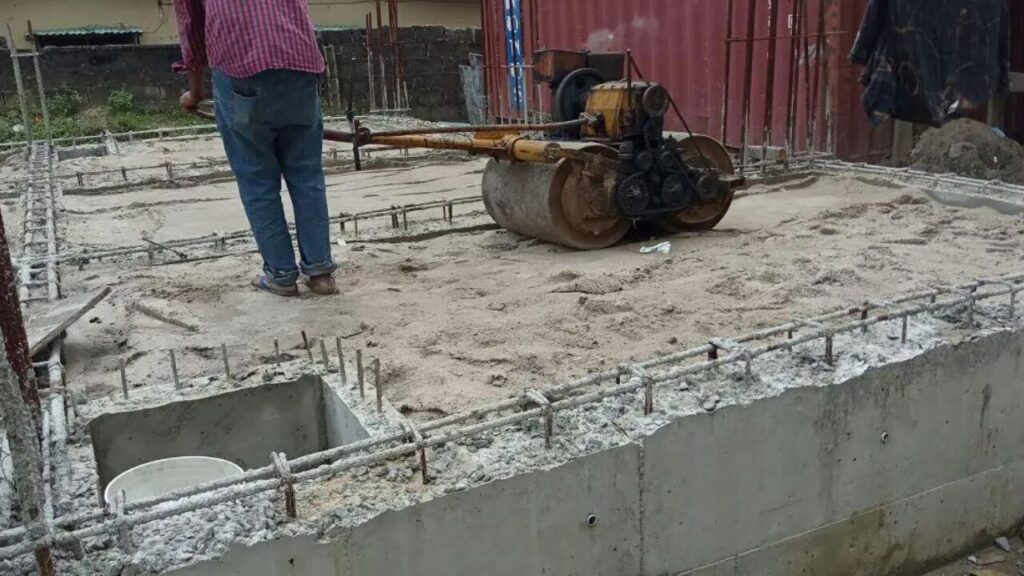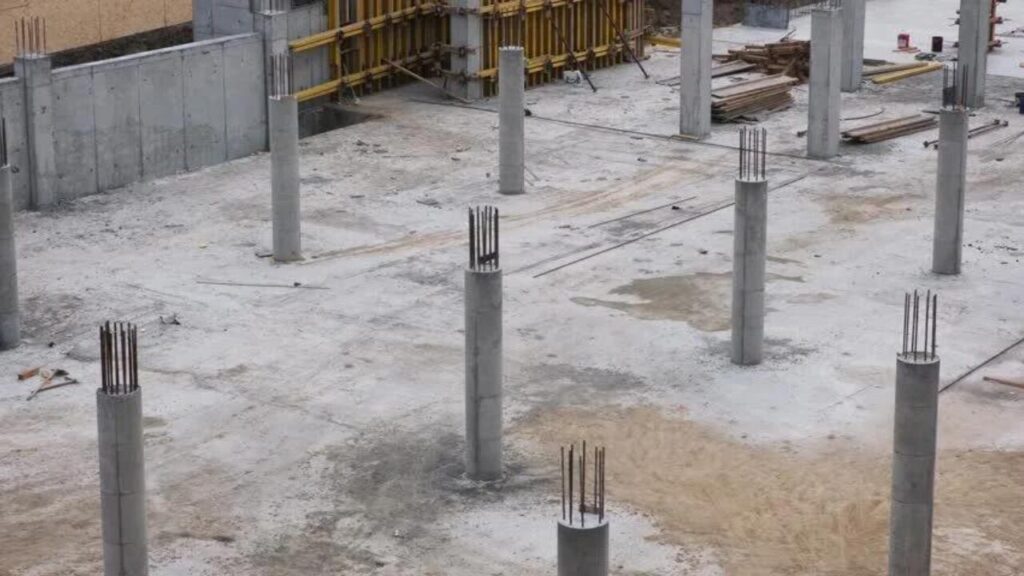The foundation of any building is one of the most critical parts of any construction.
Table of Contents
ToggleIt supports the entire structure. In Nigeria, several types of building foundations are common.
Each type is suitable for different soil conditions and building requirements.
This blog post will explore the four main types of building foundations used in Nigeria.
We will discuss their features, advantages, and suitability for various conditions.
#1. STRIP FOUNDATIONS
Strip foundations are one of the most common foundation types in Nigeria.
They are also known as strip footings. These foundations are continuous strips of concrete.
They are used to support load-bearing walls.

Features
1. Continuous Concrete Strips: The foundation consists of long, continuous strips of
concrete.
2. Depth: Typically shallow, with a depth ranging from 0.5 to 2 meters.
3. Width: The width depends on the load of the building and soil type. It is usually wider
than the wall it supports.
Advantages
1. Cost-Effective: Strip foundations use less concrete and steel, making them cheaper.
2. Easy Construction: They are straightforward to construct, which saves time and labor.
3. Suitable for Various Soils: They work well in different soil types, especially those with
good bearing capacity.
Suitability
Strip foundations are ideal for small to medium-sized buildings.
They are commonly used for residential houses and low-rise buildings.
This type is particularly effective in areas with stable soil conditions.
Also read – I Want To Build a House on My Land Where Do I Start
#2. RAFT FOUNDATIONS
Raft foundations, also known as mat foundations, are large concrete slabs.
They cover a significant area beneath a building.
This type of foundation spreads the load of the building over a large area.

Features
1. Large Slab of Concrete: The foundation is a single, thick concrete slab.
2. Reinforcement: The slab is reinforced with steel bars to enhance its strength.
3. Thickness: The thickness can vary based on the building’s load and soil conditions.
Advantages
1. Distributes Load Evenly: The foundation spreads the building’s load over a large area,
reducing pressure on the soil.
2. Suitable for Weak Soils: Ideal for areas with weak or unstable soils.
3. Reduces Settlement: Helps minimize differential settlement of the building.
Suitability
Raft foundations are suitable for large structures and areas with weak soils.
They are commonly used for commercial buildings, large residential complexes, and industrial buildings.
Also read – Estimate Cost of Building a House in Nigeria
#3. PILE FOUNDATIONS
Pile foundations are deep foundations.
They consist of long, slender columns made of concrete, steel, or timber.
These piles are driven deep into the ground to reach stable soil or rock.

Features
1. Deep Foundations: Piles extend deep into the ground, sometimes up to 50 meters or
more.
2. Materials: Piles can be made of concrete, steel, or timber.
3. Types: There are different types of piles, including end-bearing piles and friction piles.
Advantages
1. Suitable for Poor Soil Conditions: Ideal for areas with weak or highly compressible
soils.
2. Support Heavy Loads: Can support very heavy structures and high-rise buildings.
3. Minimize Settlement: Deep placement reduces the risk of excessive settlement.
Suitability
Pile foundations are best for large buildings and structures in areas with poor soil conditions.
They are commonly used for bridges, towers, high-rise buildings, and waterfront structures.
#4. PAD FOUNDATIONS
Pad foundations are individual bases or pads that support single points of load.
They are commonly used for supporting columns or pillars.

Features
1. Isolated Concrete Pads: The foundation consists of separate concrete pads.
2. Reinforcement: Each pad is reinforced with steel to provide additional strength.
3. Placement: Pads are placed under each structural column.
Advantages
1. Cost-Effective: Uses less concrete and steel compared to other foundation types.
2. Easy to Construct: Simple design makes them quick and easy to build.
3. Suitable for Light Loads: Works well for buildings with relatively light loads.
Suitability
Pad foundations are suitable for small buildings, such as residential homes, sheds, and small
commercial buildings. They are also used for light structures like billboards and fences.
Also read – How many months does it take to build a house in Nigeria?
CHOOSING THE RIGHT FOUNDATION
Selecting the appropriate foundation type for a building in Nigeria depends on several factors.
These include soil conditions, building load, and construction budget.
Here are some key considerations:
Soil Conditions
1. Stable Soil: Strip foundations are ideal for areas with stable, high-bearing-capacity soils.
2. Weak or Unstable Soil: Raft and pile foundations are better for areas with weak or
unstable soils.
Building Load
1. Light Load: Pad and strip foundations are suitable for buildings with light to moderate
loads.
2. Heavy Load: Pile and raft foundations are necessary for structures with heavy loads.
Budget
1. Cost-Effective Options: Strip and pad foundations are generally more affordable.
2. Higher Budget: Pile and raft foundations are more expensive due to the materials and
labor required.
Climate and Environmental Factors
1. Water Table: High water tables can affect foundation choice. Pile foundations are
suitable for high water table areas.
2. Earthquake Zones: Raft foundations provide better stability in earthquake-prone areas.
CONSTRUCTION PROCESS FOR EACH FOUNDATION TYPE
Here is a brief overview:
Strip Foundation Construction
- Excavation: Dig trenches to the required depth and width.
- Formwork: Set up formwork to hold the concrete in place.
- Reinforcement: Place steel reinforcement bars in the trenches.
- Pouring Concrete: Pour concrete into the trenches and allow it to set.
- Curing: Cure the concrete to achieve maximum strength.
Raft Foundation Construction
- Excavation: Excavate the entire area to the required depth.
- Base Preparation: Compact the soil and place a layer of blinding concrete.
- Formwork and Reinforcement: Set up formwork and place steel reinforcement.
- Pouring Concrete: Pour the concrete slab and level it.
- Curing: Cure the concrete slab to ensure it gains strength.
Pile Foundation Construction
- Site Investigation: Conduct soil tests to determine the depth and type of piles required.
- Pile Installation: Drive or drill piles into the ground to the required depth.
- Pile Caps: Construct pile caps to connect the piles and distribute the load.
- Connecting Beams: Install beams to connect the pile caps and support the structure.
Pad Foundation Construction
- Excavation: Dig holes for each pad foundation to the required depth.
- Formwork: Set up formwork for each pad.
- Reinforcement: Place steel reinforcement in the formwork.
- Pouring Concrete: Pour concrete into the formwork and allow it to set.
- Curing: Cure the concrete pads to achieve maximum strength.











2 thoughts on “What are the 4 Types of Building Foundations in Nigeria?”
This is a great article that provides a clear overview of the four most common types of building foundations. I found the information about the suitability of each type of foundation to be particularly helpful.
I was wondering if you could elaborate on the specific factors that engineers consider when choosing a foundation type for a particular building project. For instance, how does the weight of the building and the soil conditions at the building site influence the decision-making process?
Okay, we will. Thank you